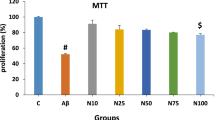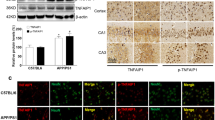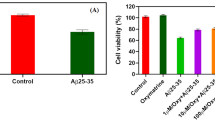Abstract
Excessive accumulation and deposition of amyloid-beta (Aβ) has been considered as a pivotal event in the pathogenesis of Alzheimer’s disease (AD). Neuronal apoptosis is one of the characteristics of AD, which is a possible mechanism underlying Aβ-induced neuronal neurotoxicity. Neuroglobin (Ngb) is a newly discovered vertebrate heme protein that exhibits neuroprotective functions against cell death associated with hypoxic and amyloid insult. However, until now, the exact mechanism of neuroglobin’s protective action has not been determined. To investigate the potential neuroprotective roles and mechanisms of Ngb, transgenic AD mice (APPswe/PSEN1dE9) and SH-SY5Y cells transfected with pAPPswe were enrolled into the study. In vivo, overexpression of Ngb via intracerebroventricular injection with pNgb attenuated memory, cognitive impairment, and plaque generations. In pAPPswe transfected SH-SY5Y cells, Ngb not only decreased the generation of Aβ42, but also attenuated mitochondrial dysfunction and apoptosis through suppressing the activation of caspase-3, caspase-9 by Akt activating phosphorylation, which were restrained by phosphatidylinositol 3-kinase inhibitor (LY294002). Our data indicate the anti-apoptotic property of Ngb may play a neuroprotective role against AD.






Similar content being viewed by others
References
Antao ST, Duang TT, Aran R, Witting PK (2010) Neuroglobin overexpression in cultured human neuronal cells protects against hydrogen peroxide insult via activating phosphoinositide-3 kinase and opening the mitochondrial K (ATP) channel. Antioxid Redox Signal 13(6):769–781
Brittain T, Skommer J, Raychaudhuri S, Birch N (2010) An antiapoptotic neuroprotective role for neuroglobin. Int J Mol Sci 11(6):2306–2321
Brunori M, Vallone B (2006) A globin for the brain. FASEB J 20:2192–2197
Burmester T, Weich B, Reinhardt S, Hankeln T (2000) A vertebrate globin expressed in the brain. Nature 407(6803):520–523
De Calignon A, Fox LM, Pitstick R et al (2010) Caspase activation precedes and leads to tangles. Nature 464(7292):1201–1204
Fordel E, Thus L, Martinet W et al (2006) Neuroglobin and cytoglobin overexpression protects human SH-SY5Y neuroblastoma cells against oxidative stress-induced cell death. Neurosci Lett 410(2):146–151
Francois G, Daigen X, George S et al (1999) Involvement of caspases inproteolytic cleavage of Alzheimer’ amyloid-beta precursor protein and amyloidogenin Abeta peptide formation. Cell 97(3):395–406
Galimberti D, Scarpini E (2011) Alzheimer’s disease: from pathogenesis to disease-modifying approaches. CNS Neurol Disord Drug Targets 10(2):163–174
Golde TE, Dickson D, Hutton M (2006) Filling the gaps in the Abeta cascade hypothesis of Alzheimer’s disease. Curr Alzheimers Res 3(5):421–430
Hajra KM, Liu JR (2004) Apoptosome dysfunction in human cancer. Apoptosis 9:691–704
Hedskog L, Petersen CA, Al S et al (2011) Gamma-secretase complexes containing caspase-cleaved presenlin-1 increase intracellular Aβ42/Aβ40 ratio. Cell Mol Med 15(10):2150–2163
Hoi CP, Ho YP, Baum L, Chow AH (2010) Neuroprotective effect of honokiol and magnolol compunds from Magnolia officinalis on beta-amyloid-induced toxicity in PC12 cells. Phytother Res 24(10):1538–1542
Jin K, Mao Y, Mao X, Xie L, Greenberg DA (2010) Neuroglobin expression in ischemic stroke. Stroke 41(3):557–559
Khan AA, Mao XO, Banwait S, Jin K, Greenberg DA (2007) Neuroglobin attenuates beta-amyloid neurotoxicity in vitro and transgenic Alzheimer phenotype in vivo. Proc Natl Acad Sci U S A 104(48):10114–10119
Li RC, Pouranfar F, Lee SK, Morris MW, Wang Y, Gozal D (2008) Neuroglobin protects PC12 cells against beta-amyloid-induced cell injury. Neurobiol Aging 29(12):1815–1822
Li C, Zhao R, Gao K et al (2011) Astrocytes: implication for neuroinflammatory pathogenesis of Alzheimer’s disease. Curr Alzheimers Res 80(1):67–80
Lim GP, Chu T, Yang F, Beech W, Frautschy SA, Cole GM (2001) The curry spice curcumin reduces oxidative damage and amyloid pathology in an Alzheimer transgenic mouse. J Neurosci 21(21):8370–8377
Ord EN, Shirley R, McClure JD et al (2013) Combined antiapoptotic and antioxidant approach to acute neuroprotection for stroke in hypertensive rats. J Cereb Blood Flow Metab 33(8):1215–1224
Raina AK, Hochman A, Zhu X et al (2001) Abortive apoptosis in Alzheimer’s disease. Acta Neuropathol 101(4):305–310
Redlak MJ, Miller TA (2011) Targeting PI3K/Akt/HSP90 signaling sensitizes gastric cancer cells to deoxycholate-induced apoptosis. Dig Dis Sci 56(2):323–329
Richard CL, Pouranfar F, Lee SK, Matthew WM, Yang W, Gozal D (2008) Neuroglobin protects PC12 cell against β-amyloid induced cell injury. Neurobiol Aging 29(12):1815–1822
Schmidt M, Giessl A, Laufs T, Hankeln T, Wolfrum U, Burmester T (2003) How does the eye breathe? Evidence for neuroglobin-mediated oxygen supply in the mammalian retina. J Biol Chem 278:1932–1935
Singh S, Zhuo M, Gorgun FM, Englander EW (2013) Overexpressed neuroglobin raises threshold for nitric oxide-induced impairment of mitochondrial respiratory activities and stress signaling in primary cortical neurons. Nitric Oxide 32:21–28
Song Z, Insel PS, Buckley S et al (2015) Brain amyloid-beta burden is associated with disruption of intrinsic functional connectivity within the medial temporal lobe in cognitively normal elderly. J Neurosci 35(7):3240–3247
Sun Y, Jin K, Mao XO et al (2005) Effect of aging on neuroglobin expression in rodent brain. Neurobiol Aging 26(2):275–278
Sun F, Mao X, Xie L, Greenberga DA, Jin K (2013) Neuroglobin protein is upregulated in Alzheimer’s disease. J Alzheimers Dis 36(4):659–663
Szymanski M, Wang R, Fallin MD, Bassett SS, Avramopoulos D (2010) Neuroglobin and Alzheimer’s dementia: genetic association and gene expression changes. Neurobiol Aging 31(11):1835–1842
Wang Y, Xu S, Cao Y et al (2014) Folate deficiency exacerbates apoptosis by inducing hypomethylation and resultant overexpresssion of DR4 together with altering DNMTs in Alzhemer’s disease. Int J Clin Exp Med 7(8):1945–57
Wei X, Yu Z, Cho KS et al (2011) Neuroglobin is an endogenousneuroprotectant for retinal ganglion cells against glaucomatousdamage. Am J Pathol 179:2988–1997
Yu W, Mechawar N, Krantic S, Quirion R (2010) Evidence for the involvement of apoptosis-inducing factor-mediated caspase-independent neuronal death in Alzheimer disease. Am J Pathol 176(5):2209–2218
Yuan JY, Yanker BA (2000) Apoptosis in the nervous system. Nature 407(6805):802–809
Zara S, Di Stefano A, Nasuti C et al (2011) NOS-mediated morphological and molecular modifications in rats infused with Aβ(1–40), as a model of Alzheimer’s disease, in response to a new lipophilic molecular combination codrug-1. Exp Gerontol 46(10):273–281
Zara S, Porzionato A, De Colli M et al (2013) Human carotid body neuroglobin, vascular endothelial growth factor and inducible nitric oxide synthase expression in heroin addiction. Histol Histopathol 28(7):903–911
Zhang X, Yin WK, Shi XD, Li Y (2011) Curcumin activates wnt/β-catenin signaling pathway through inhibiting the activity of gsk-3β in vitro. Eur J Pharm Sci 42(5):540–546
Zhao R, Zhang Z, Song Y, Wang D, Qi J, Wen S (2011) Implication of phosphatidylinositol-3kinas/Akt/glycogen synthase kinase-3beta pathway in ginsenoside Rb1’s attenuation of beta-amyloid-induced neurotoxicity and tau phosphorylation. J Ethnopharmacol 133(3):1109–1116
Zhu J, Tang W (2010) Cerebroprotection with recombinant neuroglobin plasmid in a rat model of focal cerebral ischemia. Neural Regen Res 5(1):52–57
Acknowledgments
This work was supported by the National Natural Science Foundation of China (NSFC: 81100948; NSFC: 81271426). We thank Deng Yu and Lin Xiao for their expert technical assistance in cell culture and immunocytochemistry.
Conflicts of Interest
The authors declare no conflicts of interest.
Author information
Authors and Affiliations
Corresponding author
Rights and permissions
About this article
Cite this article
Li, Y., Dai, Yb., Sun, Jy. et al. Neuroglobin Attenuates Beta Amyloid-Induced Apoptosis Through Inhibiting Caspases Activity by Activating PI3K/Akt Signaling Pathway. J Mol Neurosci 58, 28–38 (2016). https://doi.org/10.1007/s12031-015-0645-z
Received:
Accepted:
Published:
Issue Date:
DOI: https://doi.org/10.1007/s12031-015-0645-z




